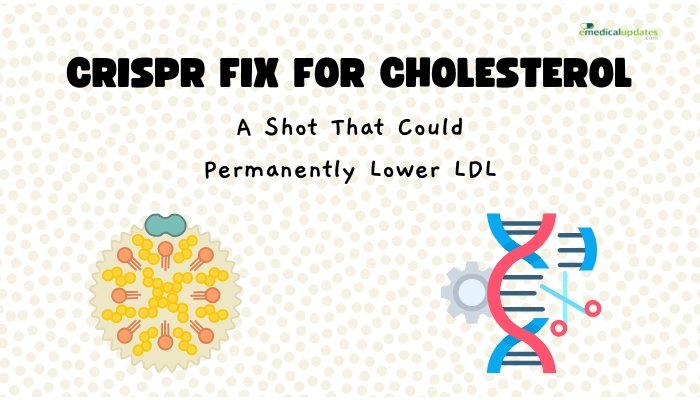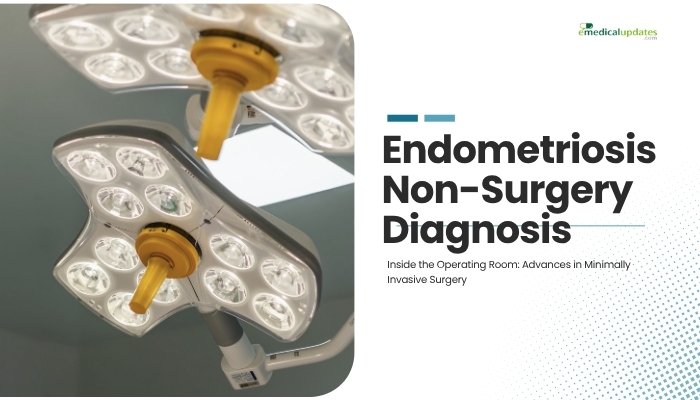Introduction
High levels of LDL (“bad”) cholesterol remain a primary risk factor for atherosclerosis and heart disease, the leading cause of death worldwide. Despite effective treatments like statins and PCSK9 inhibitors, many patients struggle with medication side effects, adherence, or incomplete response.
Enter CRISPR gene editing: a tool that modifies DNA with remarkable precision. New research shows the possibility of lowering LDL by permanently shutting down or modifying specific genes that contribute to high cholesterol. This article outlines how a CRISPR-based “cholesterol shot” works, the preliminary trial results, and what it might mean for cardiovascular care.
The Burden of High LDL Cholesterol
Why LDL Matters
- Plaque Formation: Elevated LDL fosters plaque buildup in arteries (atherosclerosis), which narrows vessels and raises stroke or heart attack risk.
- Long-Term Medication: Most patients rely on daily pills (statins) or periodic injections (PCSK9 inhibitors) to maintain healthy LDL levels.
Need for a Durable Solution
Though existing therapies can be highly effective, not everyone can tolerate them, and missed doses lead to suboptimal control. A gene-based fix might drastically cut long-term reliance on medication, potentially preventing cardiovascular events altogether.
CRISPR Gene Editing at a Glance
Mechanism of CRISPR-Cas9
Developed from bacterial defense systems, CRISPR-Cas9 pinpoints specific stretches of DNA and cuts them:
- Guide RNA: A custom RNA sequence guiding Cas9 to a matching DNA region.
- Cas9 Enzyme: Executes a precise cut in the target gene.
- Cellular Repair: The break can disable (knock out) the targeted gene or fix a mutation, altering how the gene functions.
Potential Targets for LDL
For hypercholesterolemia, typical CRISPR interventions might:
- Knock Out PCSK9: A gene that, when overactive, hinders LDL receptors responsible for clearing LDL from the bloodstream. Disabling PCSK9 ensures more LDL is removed.
- Modify APOB or ANGPTL3: Additional genes influencing cholesterol metabolism.
The “Cholesterol Shot” in Development
Preclinical Success
Initial animal models—like mice or non-human primates—showed:
- Significant LDL Reduction: Single CRISPR injections lower LDL by up to 50–60%.
- Long-Lasting Effects: Months after the injection, cholesterol levels remained lower, suggesting a durable gene change.
Early Human Trials
Some biotech companies have initiated Phase I or Phase I/II trials, enrolling participants with severe or familial hypercholesterolemia:
- Safety: Evaluating potential off-target edits or unforeseen immune reactions to the gene editor.
- Dosage Determination: Finding an optimal dose that achieves sufficient gene editing without toxicity.
- Preliminary Efficacy: Tracking patients’ LDL levels weeks or months after injection.
Advantages Over Conventional Therapies
- One-and-Done: Patients may skip the daily or biweekly medication routine if gene editing remains stable over time.
- No Adherence Issues: Eliminates missed doses or prescription refills.
- Potential Cost-Effectiveness: Though upfront costs might be high, it may reduce lifelong spending on medications and complications from poorly controlled LDL.
Challenges and Considerations
Off-Target Editing Concerns
CRISPR, especially older variants, can occasionally snip unintended DNA sites:
- Cancer Risk: Spurious cuts near tumor suppressor genes or other vital loci may pose long-term hazards.
- Minimized by High-Fidelity Cas9: Enhanced versions reduce such “off-target” events, but ongoing screening and follow-up remain crucial.
Immune Response
Some individuals might have preexisting antibodies to Cas9 or the vector used (like adeno-associated virus). This might reduce efficiency or spark inflammatory side effects.
Regulatory and Ethical Aspects
Gene editing for a non-fatal chronic condition—like hypercholesterolemia—opens debate about cost, prioritization, and potential expansions to “enhancement” uses. Regulatory pathways demand robust proof that benefit outweighs risk.
The Road Ahead
Larger-Scale Trials
Phase II/III studies must enroll hundreds or thousands of individuals from varied ethnic and age groups, clarifying:
- Real-World Effectiveness: Are LDL levels reduced consistently across populations?
- Long-Term Safety: Are negative outcomes, like abnormal lab findings or organ toxicity, minimal over years?
Potential for Other Lipid Disorders
If success is found in LDL, the approach could also address Lp(a) (lipoprotein(a)) or conditions like familial chylomicronemia by targeting relevant genetic pathways. Multiple “cholesterol shots” might soon exist for distinct lipid subgroups.
Integrating into Cardiac Prevention
Clinicians imagine a future in which individuals at extreme risk—those with familial hypercholesterolemia or multiple cardiac risk factors—could opt for a CRISPR injection as early as young adulthood, drastically cutting cardiovascular disease incidence.
Frequently Asked Questions
- Will this therapy completely replace statins?
- Possibly for select high-risk or drug-intolerant patients. Many may still prefer daily pills if the gene therapy cost or risk is too high. The approach might coexist with standard treatments.
- How permanent is the genetic change?
- Potentially lifelong. Once Cas9 modifies the gene in hepatocytes, new cells keep the same edit. However, more data is needed to confirm decades-long effects.
- Could it cause other unexpected health problems?
- That’s a major question. Hence the need for thorough trials and post-marketing surveillance to watch for rare or delayed side effects.
- How soon might it be available?
- Possibly within 5–10 years if clinical trials prove safe and effective, though accelerated timeframes are plausible with robust success.
- Is it reversible?
- Typically no. Once the gene is cut or altered, reversing that change in a living system is extremely challenging. This underlines the need for very high precision and confidence.
Conclusion
A CRISPR-based injection that permanently lowers LDL stands out as a bold step forward in cardiovascular medicine. By harnessing gene editing to correct the underlying genetic drivers of high cholesterol—like PCSK9—scientists hope to slash heart disease risk with a one-time shot. Although early trial results inspire optimism, larger studies must confirm long-term safety, addressing potential off-target effects and the practicality of widespread adoption.
Still, if these obstacles are overcome, the therapy could reshape how patients and doctors approach cholesterol management, replacing indefinite medication regimens with a singular procedure that sets LDL on a healthy trajectory for life. As more data emerges, the dream of a “gene fix” for high cholesterol inches closer to becoming a mainstream reality—another triumph for the power of CRISPR and precision medicine.
References
-
Musunuru K, et al. (2021). “In vivo CRISPR base editing of PCSK9 for hypercholesterolemia.” Circulation.
-
Nissen SE, et al. (2022). “CRISPR in atherosclerosis: progress in gene therapy for LDL lowering.” JACC.
-
WHO. (2023). “Global guidelines on dyslipidemia management.”
-
CRISPR Therapeutics & Verve Press Releases. (2022). “Gene editing candidates targeting PCSK9.”




